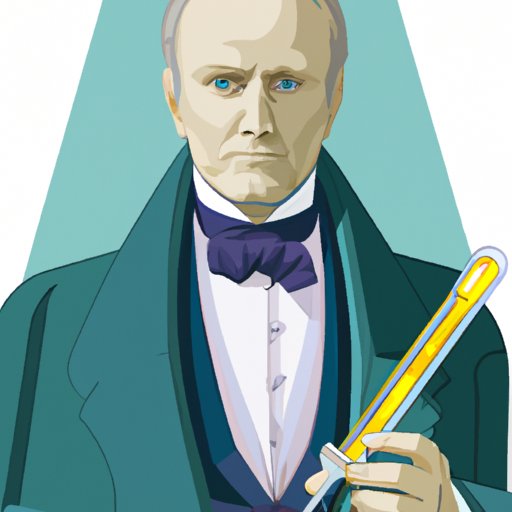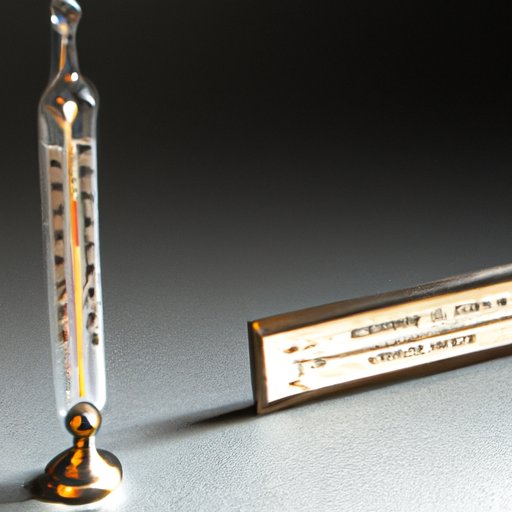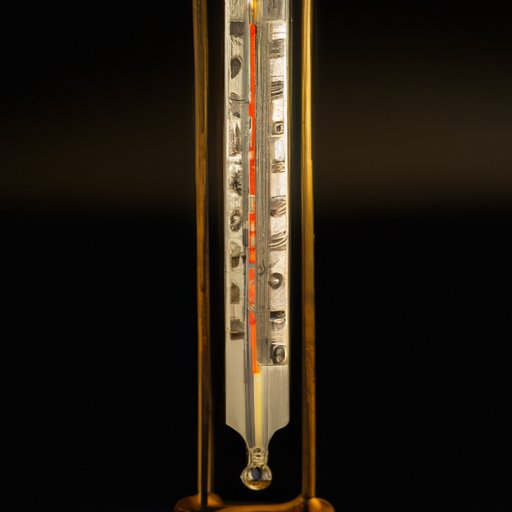Introduction
A mercury thermometer is a device used for measuring temperature accurately. It consists of a glass tube with a bulb at one end that contains a column of mercury. As the temperature changes, the mercury expands or contracts, allowing the user to read the temperature from the scale marked on the tube. The mercury thermometer has been around since the 18th century and has been an essential tool in scientific research and everyday life ever since.
This article will explore the history of the mercury thermometer and answer the question: Who invented it? We will take an in-depth look at the two scientists who contributed to its invention – Daniel Gabriel Fahrenheit and Anders Celsius – as well as their respective legacies.
History of the Mercury Thermometer: Who Invented It and How?
Temperature measurement has been around since ancient times. The first known temperature measuring instruments were created by the Greeks in the 3rd century BC. These devices were based on the principle of air expansion and contraction, using water or air as the medium. In the 16th century, Galileo Galilei developed the first thermometer that was not dependent on air pressure. He used the expansion and contraction of alcohol to measure temperature.
The mercury thermometer was first developed in the 18th century. Scientists had discovered that mercury expands and contracts in a linear fashion when exposed to heat and cold. This led to the development of the first mercury thermometer by German physicist Daniel Gabriel Fahrenheit in 1714. His design consisted of a sealed glass tube filled with mercury and a scale marked on the side. By measuring the expansion and contraction of the mercury, he was able to accurately measure temperatures.
Exploring the Origins of the Mercury Thermometer: Who Invented It?
Daniel Gabriel Fahrenheit and Anders Celsius are widely credited as the inventors of the mercury thermometer. Both men were highly influential scientists, and their work played a significant role in the development of the mercury thermometer. Let’s take a closer look at each of them and their contributions.
Daniel Gabriel Fahrenheit
Daniel Gabriel Fahrenheit (1686–1736) was a German physicist and instrument maker. He is best known for his development of the Fahrenheit temperature scale, which defines the freezing point of water as 32°F and the boiling point of water as 212°F. He also developed the first practical mercury thermometer in 1714. His design consisted of a sealed glass tube filled with mercury and a scale marked on the side. He was able to measure temperatures accurately by observing the expansion and contraction of the mercury.
Anders Celsius
Anders Celsius (1701–1744) was a Swedish astronomer and mathematician. He is best known for inventing the Celsius temperature scale, which defines the freezing point of water as 0°C and the boiling point of water as 100°C. He also developed a prototype of the modern mercury thermometer in 1742. His design was similar to Fahrenheit’s, but instead of marking the scale in degrees Fahrenheit, he marked it in degrees Celsius.

The Genius Behind the Invention of the Mercury Thermometer
Both Daniel Gabriel Fahrenheit and Anders Celsius were highly influential scientists whose work laid the foundation for the development of the mercury thermometer. Let’s take a closer look at their respective contributions to the field of temperature measurement.
Daniel Gabriel Fahrenheit’s Contributions to Temperature Measurement
In addition to inventing the first practical mercury thermometer, Daniel Gabriel Fahrenheit also developed the Fahrenheit temperature scale. He established the freezing point of water as 32°F and the boiling point of water as 212°F. This scale was widely adopted throughout Europe and is still used in some parts of the world today.
Anders Celsius’ Contributions to Temperature Measurement
Anders Celsius was the first to develop a prototype of the modern mercury thermometer in 1742. He also developed the Celsius temperature scale, which defined the freezing point of water as 0°C and the boiling point of water as 100°C. This scale is widely used throughout the world today.
Meet the Inventor of the Mercury Thermometer
Let’s take a closer look at the two scientists who contributed to the development of the mercury thermometer.
Gabriel Daniel Fahrenheit
Daniel Gabriel Fahrenheit was born in Gdansk, Poland in 1686. He studied physics and instrument making in Amsterdam before moving to Germany in 1708. He was a prolific inventor, and his inventions included the first practical mercury thermometer, the Fahrenheit temperature scale, and the mercury barometer. He died in 1736 at the age of 50.
Anders Celsius
Anders Celsius was born in Uppsala, Sweden in 1701. He studied astronomy and mathematics at Uppsala University before becoming a professor there in 1730. He is best remembered for inventing the Celsius temperature scale and developing a prototype of the modern mercury thermometer. He died in 1744 at the age of 43.
An In-depth Look at the Mercury Thermometer: What We Know About Its Inventor
Let’s take a closer look at the lives and careers of Daniel Gabriel Fahrenheit and Anders Celsius.
Life and Career of Gabriel Daniel Fahrenheit
Daniel Gabriel Fahrenheit was born in Gdansk, Poland in 1686. He studied physics and instrument making in Amsterdam before moving to Germany in 1708. He worked as an instrument maker for several years, during which time he developed the first practical mercury thermometer, the Fahrenheit temperature scale, and the mercury barometer. He died in 1736 at the age of 50.
Life and Career of Anders Celsius
Anders Celsius was born in Uppsala, Sweden in 1701. He studied astronomy and mathematics at Uppsala University before becoming a professor there in 1730. He is best remembered for inventing the Celsius temperature scale and developing a prototype of the modern mercury thermometer. He died in 1744 at the age of 43.
A Closer Look at the Mercury Thermometer: Who Invented It?
Both Daniel Gabriel Fahrenheit and Anders Celsius are widely credited as the inventors of the mercury thermometer. They both developed prototypes of the device and contributed significantly to the field of temperature measurement.
Daniel Gabriel Fahrenheit’s Contributions to Temperature Measurement
Daniel Gabriel Fahrenheit is best known for his development of the Fahrenheit temperature scale, which defines the freezing point of water as 32°F and the boiling point of water as 212°F. He also developed the first practical mercury thermometer in 1714. His design consisted of a sealed glass tube filled with mercury and a scale marked on the side.
Anders Celsius’ Contributions to Temperature Measurement
Anders Celsius is best known for inventing the Celsius temperature scale, which defines the freezing point of water as 0°C and the boiling point of water as 100°C. He also developed a prototype of the modern mercury thermometer in 1742. His design was similar to Fahrenheit’s, but instead of marking the scale in degrees Fahrenheit, he marked it in degrees Celsius.

The Fascinating Story of the Mercury Thermometer and Its Inventor
The mercury thermometer is an essential tool in scientific research and everyday life. Its invention was made possible thanks to the work of two influential scientists: Daniel Gabriel Fahrenheit and Anders Celsius. Let’s take a look at their respective legacies.
Legacy of Gabriel Daniel Fahrenheit
Daniel Gabriel Fahrenheit’s most significant contribution to science was the development of the Fahrenheit temperature scale, which is still used in some parts of the world today. He also developed the first practical mercury thermometer and the mercury barometer.
Legacy of Anders Celsius
Anders Celsius is best remembered for inventing the Celsius temperature scale, which is widely used throughout the world today. He also developed a prototype of the modern mercury thermometer.
Conclusion
The mercury thermometer is an essential tool in scientific research and everyday life. Its invention was made possible thanks to the work of two influential scientists: Daniel Gabriel Fahrenheit and Anders Celsius. Fahrenheit developed the first practical mercury thermometer and the Fahrenheit temperature scale, while Celsius developed a prototype of the modern mercury thermometer and the Celsius temperature scale. Their legacies live on in the form of these two temperature scales, which are still used throughout the world today.
(Note: Is this article not meeting your expectations? Do you have knowledge or insights to share? Unlock new opportunities and expand your reach by joining our authors team. Click Registration to join us and share your expertise with our readers.)
